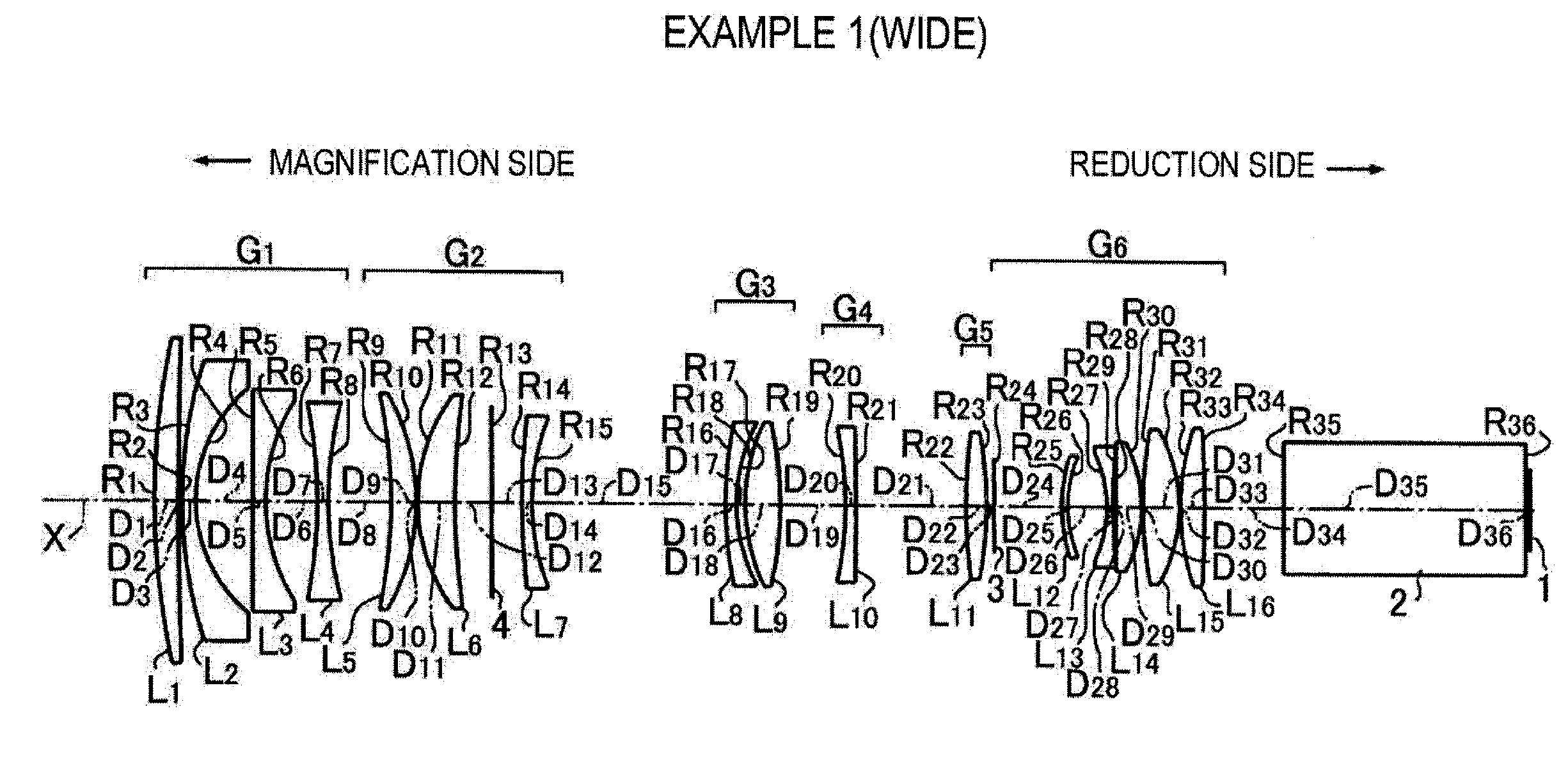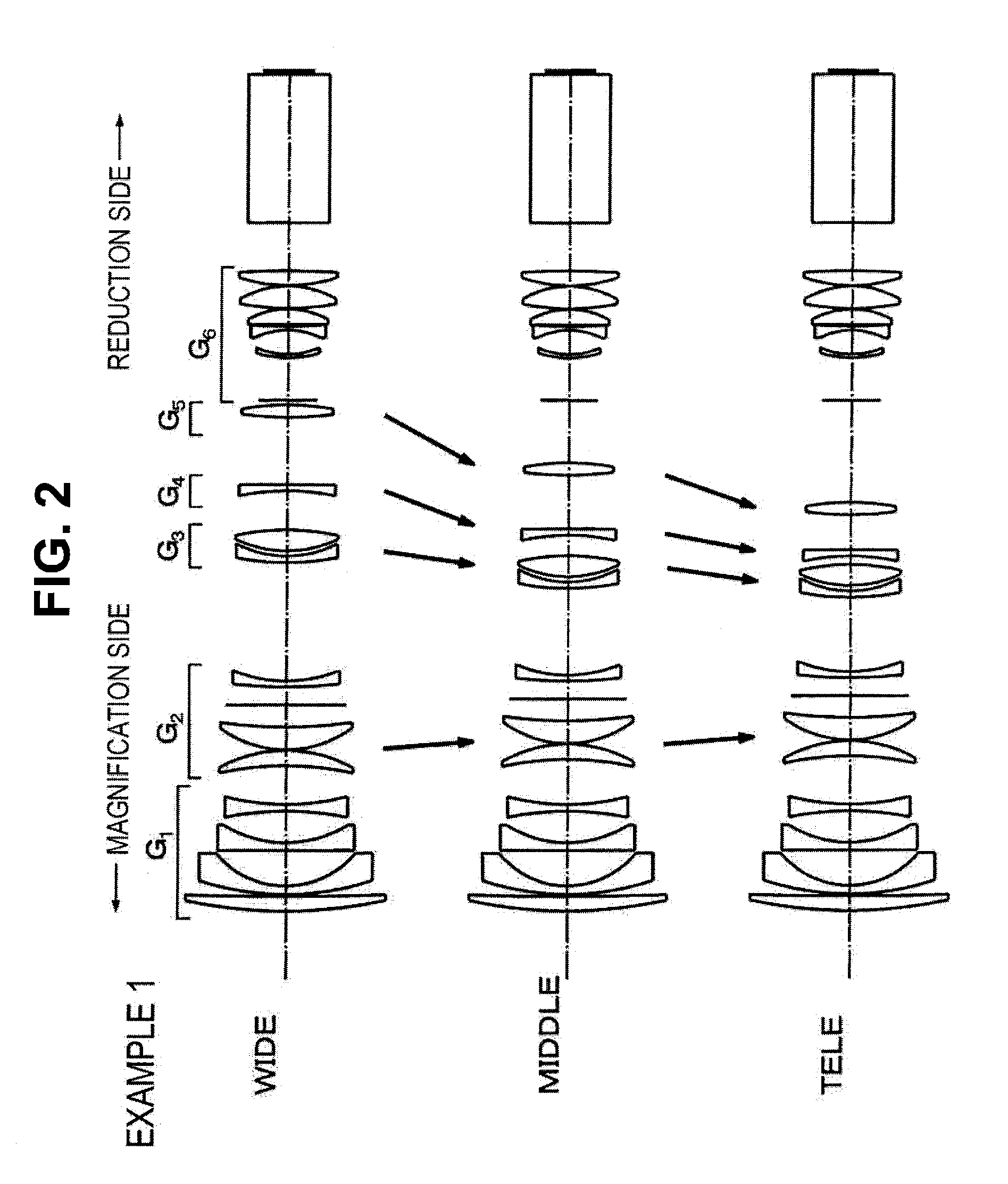Projection zoom lens and projection display device
a technology of projection display device and zoom lens, which is applied in the direction of printers, instruments, cameras focusing arrangement, etc., can solve the problems of complex adjustment of operation, lens not suitable for movie theaters, inefficient preparation of individual lenses corresponding to various throw ratios in terms of costs, etc., and achieves high zoom ratio, wide angle of view of zoom lens, and maintain the effect of fno
- Summary
- Abstract
- Description
- Claims
- Application Information
AI Technical Summary
Benefits of technology
Problems solved by technology
Method used
Image
Examples
example 1
[0117]As described above, the projection zoom lens according to Example 1 shown in FIGS. 1 to 3 includes: a first lens group G1 that is fixed when power varies, has a focusing function, and has a negative refractive power; a second lens group G2 with a positive refractive power, a third lens group G3 with a positive refractive power, a fourth lens group G4 with a negative refractive power, and a fifth lens group G5 with a positive refractive power that are moved in the direction of the optical axis X relative to each other in order to continuously vary power and correct the movement of an image surface due to the continuous power variation; and a sixth lens group G6 that is fixed when power varies, has a positive refractive power, and includes an aperture diaphragm 3 provided closest to the magnification side. The first to sixth lens groups are arranged in this order from the magnification side. A glass block 2, which is mainly a color composition prism, and an image display surface...
example 2
[0131]As shown in FIG. 4, the basic structure of a projection zoom lens according to Example 2 is similar to that according to Example 1 except that the tenth lens L10 in the fourth lens group G4 is a biconcave lens and the thirteenth lens L13 in the sixth lens group G6 is a planoconcave lens having a concave surface facing the magnification side, and the fourteenth lens L14 in the sixth lens group G6 is a positive meniscus lens having a concave surface facing the magnification side.
[0132]As shown in FIG. 5, when power varies, the first lens group G1 and the sixth lens group G6 are fixed and the second to fifth lens groups G2 to G5 are moved.
[0133]In Table 2, an upper part shows the focal length f of the entire system from the wide angle end to the telephoto end in Example 2, the back focal length Bf (air equivalent distance), and Fno.
[0134]In Table 2, a middle part shows the curvature radius R of each lens surface, the thickness of the center of each lens and the air space D betwee...
example 3
[0139]As shown in FIG. 6, the basic structure of a projection zoom lens according to Example 3 is similar to that according to Example 1.
[0140]As shown in FIG. 7, when power varies, the first lens group G1 and the sixth lens group G6 are fixed, and the second to fifth lens groups G2 to G5 are moved.
[0141]In Table 3, an upper part shows the focal length f of the entire system from the wide angle end to the telephoto end in Example 3, the back focal length Bf (air equivalent distance), and Fno.
[0142]In Table 3, a middle part shows the curvature radius R of each lens surface, the thickness of the center of each lens and the air space D between the lenses, and the refractive index Nd and the Abbe number νd of each lens with respect to the d-line.
[0143]In Table 3, a lower part shows the distance D8 (variable 1) between the first lens group G1 and the second lens group G2, the distance D15 (variable 2) between the second lens group G2 and the third lens group G3, the distance D19 (variabl...
PUM
 Login to View More
Login to View More Abstract
Description
Claims
Application Information
 Login to View More
Login to View More - R&D
- Intellectual Property
- Life Sciences
- Materials
- Tech Scout
- Unparalleled Data Quality
- Higher Quality Content
- 60% Fewer Hallucinations
Browse by: Latest US Patents, China's latest patents, Technical Efficacy Thesaurus, Application Domain, Technology Topic, Popular Technical Reports.
© 2025 PatSnap. All rights reserved.Legal|Privacy policy|Modern Slavery Act Transparency Statement|Sitemap|About US| Contact US: help@patsnap.com



